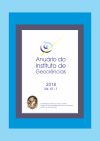Maps Algebra Application to Obtain Natural and Environmental Vulnerability of Flooding Areas
DOI:
https://doi.org/10.11137/2018_1_255_264Keywords:
Pantanal, Flood Plains, Maps AlgebraAbstract
The Pantanal Park Roads, composed of the state roads MS-184 and MS-228, are located northwest of Mato Grosso do Sul, in the Paraguay River Basin, crossing the Pantanal, whose plains are susceptible to the natural inundation pulse. Despite their cultural, ecological, landscape and tourist importance, there are lack studies that would guide the proper planning and management of the land use and occupation of the region. Thus, the objective of this work was to apply the geoprocessing technique of map algebra, based on the concept of Ecodynamics, and with the inclusion of a new thematic chart: the flood area, which represents this dynamic characteristic of the region, for obtaining of natural and environmental vulnerability charts, the latter is distinguished by considering anthropic interventions on landscape units. To do this, among other procedures, the photointerpretation of satellite images was applied to update the vectors of the RADAMBRASIL charts from the scale of 1:1,000,000 to 1:250,000, bringing minimal representativeness of the relevant regional characteristics, as well as the application of the proposed technique. The results obtained are the maps of natural and environmental vulnerability to erosive processes, and the EPP are both natural and environmentally predominant with moderately stable/vulnerable areas with a tendency to be moderately vulnerable, and, any changes that occur in the landscape unit, can elevate its status to vulnerable to erosive processes, increasing the risk of soil loss.Downloads
Download data is not yet available.
Downloads
Published
2019-09-09
How to Cite
Cavazzana, G. H. (2019) “Maps Algebra Application to Obtain Natural and Environmental Vulnerability of Flooding Areas”, Anuário do Instituto de Geociências. Rio de Janeiro, BR, 41(1), pp. 255–264. doi: 10.11137/2018_1_255_264.
Issue
Section
Article
License
This journal is licensed under a Creative Commons — Attribution 4.0 International — CC BY 4.0, which permits use, distribution and reproduction in any medium, provided the original work is properly cited.















